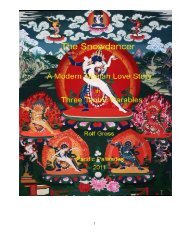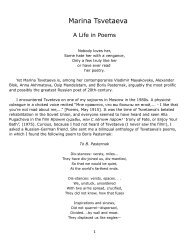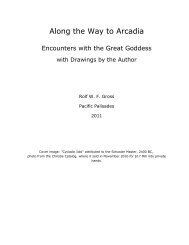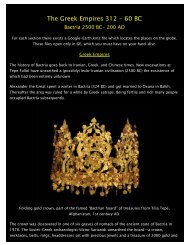ack to the viewer attended to Mary’s robe. The altar wings depicted pairs of saints <strong>and</strong> bishops. She quickly glanced atthe label: San Giovenale Triptych, Masaccio, 1422."Masaccio. who painted this triptych for a Tuscan village church, was an extraordinary man. It was his first altarcommission. A few years earlier Brunelleschi had invented three-dimensional perspective drawing. Massacio was thefirst to use it in painting. He also conceived of employing light <strong>and</strong> shade to give his figures body <strong>and</strong> form. Hiscontemporaries suspected him of magic! Compare Massacio’s throne with that of the Duccio Madonna. You see how itsarmrests recede towards an imaginary point behind the Madonna."Alex<strong>and</strong>ra peered at the revolutionary Masaccio. She had to admit, the throne appeared more like a chair, but she couldnot tell why, nor could she see Walter’s imaginary point.Challenged by the skeptical look in her blue eyes, a desperate Walter outdid himself, produced a piece of paper <strong>and</strong> apencil from his pocket, <strong>and</strong> drew, on a nearby window sill, a point from which radiated several lines. "This is theimaginary point <strong>and</strong> these lines are called vanishing lines. They are not shown in the painting, the artist only imaginesthem."Fascinated Alex<strong>and</strong>ra watched this otherwise so impractical man insert the circular base of the throne, its armrests, legs,<strong>and</strong> the high back of the chair into the framework of those lines. For the first time in her life she saw a three-dimensionalobject being created on a flat surface. A wave of recognition passed over her face. The method looked exceedinglysimple.Walter smiled satisfied at his drawing. "Brunelleschi’s Perspective in a nutshell!" He looked around <strong>and</strong> then at her. "Hemust have guided my h<strong>and</strong>. I have never done that before!""Now I see what you see!" she exclaimed <strong>and</strong> clapped her h<strong>and</strong> over her mouth.Walter smiled beguiled. He awkwardly hid the sketch in his pocket. "And now you don’t! Look at the triptych again. Whatdo you see?"Excited she pointed at the receding armrests of the throne <strong>and</strong> the angels in the foreground, which gave the paintingdepth.Walter stepped away from her. "Yes, yes, but did you also notice that the Christ child is a naked village urchin who stickshis two fingers squarely into his mouth? The same fingers that used to bless the believers!"Walter laughed happily as she nodded with a flushed face. She had been so preoccupied with visualizing the imaginaryvanishing lines that she had not paid any attention to the child <strong>and</strong> his little gesture."Renaissance painting began with the Christ child sucking his fingers! Can you imagine how excited Masaccio’scontemporaries must have been, awed <strong>and</strong> delighted? This child <strong>and</strong> his mother lived in their villages! God himself waswalking among them."He pointed at the figures on the side panels. "Neither are these sturdy saints with their beards <strong>and</strong> dark, gloomydemeanor any longer superhuman. You see how Masaccio uses light <strong>and</strong> shading to give his figures body? Look at theface of the Madonna with its lovely dimples—she is alive!"Alex<strong>and</strong>ra’s sensitive features were glowing. Walter looked at his rapt student. "Unfortunately Masaccio died very young,he lived only twenty-seven years. But what effect he had on his contemporaries!"He prepared to leave. "Let me take you to another painting from a different part of Europe to show you how quickly thisnew way of seeing spread in the fifty years following Massacio."Without looking right or left, passing through droves of people, he walked her rapidly to the farthest corner of the museumwhere in a narrow corridor hung a very large triptych."This is the Pontinari Altarpiece painted in 1475 by the Flemish painter Hugo van der Goes. It has been crammed intothis forgotten corner because it was not painted by an Italian artist. We are st<strong>and</strong>ing much too close, but never mind, itsdetails are so extraordinary that you may as well examine them from close up."Alex<strong>and</strong>ra tried to take it all in. On the center panel the Madonna was kneeling before her naked child—a real baby, nolonger the future Christ—lying on a lowly blanket on the ground. Still, this humble earthling was the center of attention.Three flocks of kneeling angels in colorfully embroidered garments surrounded the child. Joseph in a red coat on the left<strong>and</strong> three burly shepherds on the opposite side gazed at the newborn in rapture.Walter, h<strong>and</strong>s behind his back, quietly moved aside. Alex<strong>and</strong>ra now noticed that directly before her appeared two vasesof flowers, a bunch of red tiger lilies <strong>and</strong> white <strong>and</strong> blue iris in one, blue columbines in the other, their petals strewn allacross the foreground in front of the child. The lifelike detail of these flowers took her breath away. She turned to Walter."This must be the most beautiful painting I have ever seen. Its translucent clarity <strong>and</strong> warm intimacy would beunimaginable, did not st<strong>and</strong> before it.""Yes, the Flemish have different eyes. You have not looked at the side panels. See the splendid garments of the ladieson the right? And on the left st<strong>and</strong> two holy men, <strong>and</strong> kneeling, in old-fashioned, piously in inverted perspective, themuch smaller Pontinari, the sponsor of the altar with his two sons. His wife <strong>and</strong> daughter kneel on the other side.Pontinari was a rich merchant, like <strong>Konrad</strong>’s ancestor. The self-important merchants <strong>and</strong> the cocky Italian princes paidfor this revolution in art. Thanks to their riches Tuscany <strong>and</strong> Fl<strong>and</strong>ers became the birthplaces of the Renaissance."Walter in his excitement took her arm. "Let me show you two Italian paintings that share the clarity of this van der Goes50
ut are, unjustly, much more famous."They walked back to the Italian section. On their way Walter, his eyes burning, exclaimed. "The discovery of this newway of seeing revolutionized everything, painting, philosophy, <strong>and</strong> the belles lettres. Tonight I will show you a literaryexample of this revolution. From the two-dimensional world of the Middle Ages modern, egocentric, three-dimensionalman was born, fully formed—on his own power. Forgive me, I wanted to say without the help of God. This is the greatexperience of the quattrocento, the consequences of which still have not reached Russia <strong>and</strong> the East."He went to show her Botticelli’s Birth of Venus. Venus in her full beauty st<strong>and</strong>s on a seashell about to step on l<strong>and</strong>. AuntSophia had given her a reproduction of this painting, it had been one of her favorites. How much smaller the painting wasthan she had imagined!"You know this painting, don’t you?" asked Walter fascinated by her expressive face. She smiled. "When I was twelve, Iwas in love with this Venus. It hung over my bed for years.""After seeing the van der Goes," said Walter, "you will appreciate its clarity better. No reproduction can show this. TheBirth of Venus was painted in 1478, three years after Pontinari donated the van der Goes altar to a church in Florenz.Has van der Goes influenced Botticelli’s painting? He shows the same attention to detail but lacks van der Goes’ intimatewarmth. A classical, southern brilliance suffuses Botticelli’s paintingscontrasting with their mysterious strangeness."He walked a few steps to the right <strong>and</strong> pointed at another much larger Botticelli. "Here is the equally famous Primaverapainted a year later. It is even stranger than his Venus on the Seashell."Alex<strong>and</strong>ra had also seen reproductions of it, but never examined it closely: On the left three maidens danced indiaphanous robes—the three Graces? In the center stood a young woman with a red stole—a heathen Madonna,Aphrodite?–who held her quiet, serene head tilted. Her dress was gathered under her breasts. Could Manana copy thatdress? To Aphrodite’s right strode another young woman—Spring or Flora?–distributing flowers from a fold into whichshe had gathered her flowing garment. Her highly sculpted face had an almost masculine strength, which, though no lessbeautiful, contrasted with the serenity of Aphrodite’s face. A young man pointed towards the sky with a scepter—Hermeswith his caduceus? Oranges hung in the dense foliage of trees that shaded the scene. All women except Aphroditewalked barefoot on the flower-covered ground. At the right margin a disconcerting scene: a male, winged figure in awindblown blue drapery—Zephyr?—flying through the trees in pursuit of a fleeing girl from whose mouth sprouted flowers—she must be Ovid’s Chloe!Alex<strong>and</strong>ra tried to compare both paintings from a distance. "You know," she said to Walter, "were I not aware that theyare by Botticelli <strong>and</strong> were painted in the fifteenth century, I would think they are from the Northern Gothic. You say theyare mysterious, I think, it is this Gothic flavor that makes them so. Masaccio’s Christ child is more of this world than thesebeautiful women who appear almost unreal. Who are they? And why are they all struck by sadness?"Walter smiled. "We really don’t know. People have speculated about their meaning <strong>and</strong> identity since Botticelli paintedthem. They are, of course, not Gothic in the historical sense, but if you mean religious, a new religion of beauty <strong>and</strong> loveyou have a point. Could it be that love made them sad?"After supper Walter brought Alex<strong>and</strong>ra a slim volume by the Latin poet Francesco Petrarca who had lived in SouthernFrance near Avignon. He opened it to a letter written in 1393 to a friend in San Sepolcro. Petrarca described hisimpressions from an ascent of Mount Ventoux in Southern France."Read it carefully, dear Alex<strong>and</strong>ra," said Walter. "This letter is a historical document extraordinaire, the first description ofan emotional experience of the beauty of l<strong>and</strong>scape. For the first time modern man sees more than just the numinosity ofthis world.""What do you mean by the numinosity of this world?" asked Alex<strong>and</strong>ra putting her coffee cup down. She had a suddenhunch that the answer was intimately related to her experience in Shuamta, that it might explain the seam between twoworlds, which she felt she was about to cross."Before Petrarca’s time the sky was not blue <strong>and</strong> a feast for the eyes, the stars were not distant worlds possibly inhabitedby other human beings, but the unimaginable, unfathomable abode of God. Before man learned to see, the sky <strong>and</strong> thestars were a transcendental foil, the aura of God who controlled man’s life. Such phenomena are called numinous."Alex<strong>and</strong>ra rose, her face tense, she reached towards Walter in great agitation. "And men acted without underst<strong>and</strong>ing ofthemselves? They were moved, forced by those numinous powers? They were too benighted to underst<strong>and</strong> their ownactions?" With burning eyes she stopped before Walter <strong>and</strong> stared at him.Walter nodded. "You say it well. The Renaissance destroyed the magic of these powers <strong>and</strong> threw man back untohimself. He became free to know himself, but he would also be forced to shoulder the responsibility of his own actions."One early morning, <strong>Konrad</strong> was roused from his sleep by Alex<strong>and</strong>ra vomiting miserably. Concerned he jumped out ofbed <strong>and</strong> found her squatting on the floor with her head over the bidet retching miserably. He supported her head, <strong>and</strong>she turned to him with a heroic smile on her drained face. "We women have to pay for every happiness, for every newinsight with our bodies. Don’t worry, dear man it is your child who is announcing its arrival. I am pregnant."He kissed her tenderly <strong>and</strong> brought her a glass of water."They call this early-morning sickness. It will go away after a few weeks. I will, if everything goes well, bear you a child in51
- Page 3 and 4: Table of Contents1. My Grandfather'
- Page 5 and 6: 1.My Grandfather's Watch among the
- Page 7 and 8: ditch beside the road.Mother was tr
- Page 9 and 10: Deep snow still covered Djvari Pass
- Page 11 and 12: "But you know nothing about how to
- Page 13 and 14: newborn baby! You won’t need a ba
- Page 15 and 16: Dadiani bent over the table, reache
- Page 17 and 18: Autumn had come to Georgia, and it
- Page 19 and 20: "Gespenstisch!" whispered Mouravi t
- Page 21 and 22: Finally, depressed by his inability
- Page 23 and 24: They slowly rode up the hill north
- Page 25 and 26: On their way back to the Lavra Alex
- Page 27 and 28: Blushing like a young girl, she gav
- Page 29 and 30: Alexandra bowed deeply to a middle-
- Page 31 and 32: All applauded and Ilia made a small
- Page 33 and 34: She had done her hair up in a new w
- Page 35 and 36: ape her. But then he must die, and
- Page 37 and 38: a rear door when she entered.If Per
- Page 39 and 40: Alexandra went purple with embarras
- Page 41 and 42: The smell of roasting lamb wafted t
- Page 43 and 44: Konrad quietly sat back. To his gre
- Page 45 and 46: The tall, dark-haired woman began w
- Page 47 and 48: She kissed him."Maybe you dream of
- Page 49: 14.Tuscany - the Wolfsons' House in
- Page 53 and 54: Alexandra had fallen into melanchol
- Page 55 and 56: She kissed him tenderly. "Niko, I a
- Page 57 and 58: obligations, and she, ever since th
- Page 59 and 60: months, was flooded with the diffus
- Page 61 and 62: could they be aroused into communal
- Page 63 and 64: 19.An unexpected encounter with Vla
- Page 65 and 66: chauffeur drop me at the station ju
- Page 67 and 68: She described her sensation of flyi
- Page 69 and 70: sky a thin, transparent blue. Imbed
- Page 71 and 72: interest in Theosophy."Marti shrugg
- Page 73 and 74: to?Mother had never mentioned any d
- Page 75 and 76: "Ah, of course, of course, ‘Eine
- Page 77 and 78: Konrad agreed that this sounded mor
- Page 79 and 80: patriarchal oak and smiled, a littl
- Page 81 and 82: have a similar situation in our vil
- Page 83 and 84: Alexandra disagreed. "Most abortive
- Page 85 and 86: a limited edition, hand-screened ma
- Page 87 and 88: Alexandra touched her necklace and
- Page 89 and 90: close!"She had hugged him, tears ru
- Page 91 and 92: The others came lumbering up the st
- Page 93 and 94: urden the heart with this task, whi
- Page 95 and 96: the colors mixed and changed depend
- Page 97 and 98: 28.Kandinsky's suprising confession
- Page 99 and 100: With kisses Alexandra removed the v
- Page 101 and 102:
He knelt, removed her knee and leg
- Page 103 and 104:
Joachim viewed Konrad with sympathe
- Page 105 and 106:
The rumbling continued at regular i
- Page 107 and 108:
Russia."She picked up a piece of br
- Page 109 and 110:
conservative pessimism, demanded th
- Page 111 and 112:
preventative method and taking it e
- Page 113 and 114:
new provocation in modern music and
- Page 115 and 116:
exhausted the Renaissance idea of b
- Page 117 and 118:
creative clairvoyance, and her shar
- Page 119 and 120:
Left to herself, Alexandra, awed, w
- Page 121 and 122:
public. She fended off the fuzzy wo
- Page 123 and 124:
ailways on strike. The strike had t
- Page 125 and 126:
Grandfather was very sad when he fo
- Page 127 and 128:
and put on his coat and shoes, he r
- Page 129 and 130:
Alexandra not in the mood to give V
- Page 131 and 132:
crowd of the fashionable and the ma
- Page 133 and 134:
established tradition with some mil
- Page 135 and 136:
42.Uncle Muravi's Benz, Tiflis1907"
- Page 137 and 138:
equisitioned a locomotive to take t
- Page 139 and 140:
meaningless rituals. That may be on
- Page 141 and 142:
lacking. I like this man, and at th
- Page 143 and 144:
are suitably ambiguous."45.The Dadi
- Page 145 and 146:
think of Munich or something else p
- Page 147 and 148:
He showed them the room where they
- Page 149 and 150:
death."Alexandra was more intereste
- Page 151 and 152:
they fought over the offering. The
- Page 153 and 154:
flew off cawing.Claudia grabbed Ale
- Page 155 and 156:
Together they were hedging out a pl
- Page 157 and 158:
the right of women to own their bod
- Page 159 and 160:
The Chinese wife of a sinologist at
- Page 161 and 162:
these texts."However, Ch'an is the
- Page 163 and 164:
times, but moved back together agai
- Page 165 and 166:
survived the Bolsheviks, the Fascis
- Page 167 and 168:
physically overwhelm her. Despite h
- Page 169 and 170:
Konrad picked up Alexandra at the t
- Page 171 and 172:
Abruptly her vision had narrowed, a
- Page 173 and 174:
the Kwadjagani, the Masters of Wisd
- Page 175 and 176:
somewhat, his back was still bent,
- Page 177 and 178:
century. The characteristic Chinese
- Page 179 and 180:
Alexandra was relieved and happy, a
- Page 181 and 182:
subconscious past her observant min
- Page 183 and 184:
Dahl leaned back in surprise. "This
- Page 185 and 186:
visions reappear. Entire armies mar
- Page 187 and 188:
"This method is not easy, I have ne
- Page 189 and 190:
He had started with representationa
- Page 191 and 192:
His hair had turned completely whit
- Page 193 and 194:
Overnight the mood in St. Petersbur
- Page 195 and 196:
daughter. His wife had left him no
- Page 197 and 198:
which was presented to him—with a
- Page 199 and 200:
"From the soldiers whom I took care
- Page 201 and 202:
He watched Alexandra’s doubting m
- Page 203 and 204:
lond, bony girl whose gray eyes loo
- Page 205 and 206:
call it intellectual humanism. It d
- Page 207 and 208:
time I asked this question I had me
- Page 209 and 210:
"I spent most of the winter of 1918
- Page 211 and 212:
We buried him in the cemetery at G
- Page 213 and 214:
ways. Corruption became the way of
- Page 215 and 216:
68.A Concert in Kreuth - Eliso1989I
- Page 217 and 218:
Eliso listened with increasing fasc
















